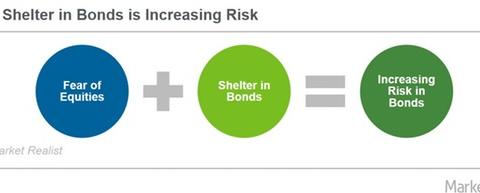Richard Bernstein: Be Safe on Your Quest for Safety
After expressing his thoughts on the Baby Boomer generation’s having become risk-averse, Richard Bernstein moved on to the topic of the safety of “safe” investments.
Nov. 16 2016, Published 3:37 p.m. ET

When “safe” investments may not be
After expressing his thoughts on the Baby Boomer generation’s having become risk-averse, Richard Bernstein moved on to the topic of the safety of “safe” investments. He said, “Safe strategies are safe until everyone thinks they are safe and makes those strategies the core of their portfolios.”
Extending his assertion, he said that if a strategy becomes exceedingly popular, it needs to be changed, because it leads to stretched valuations. Thus, if the majority of investors in a market are seeking the shelter of bonds—traditionally safe investments—they won’t stay safe, especially following changes in the macroeconomic environment.
If too many people start seeking the safety of bonds (BSV) (BIV), yields will plummet, and due to the inverse relationship between bond prices and yields, prices will likely surge. Though bond markets (TLT) (IEF) (SHY) provide shelter in times of distress, they’re not immune to wild fluctuations.
Like any other asset class, a surge in bond prices can lead to heightened volatility and speculation, increasing chances of an asset bubble that will burst sooner or later. With many investors exposed to debt instruments, even a moderate price fall could hit a wide spectrum of investors hard.
The underlying macroeconomic setup may change
If investors are bearish on equities and have been loading up on fixed-income products, things could be fine until macroeconomic factors remain the same as they were at the time of investment.
At present, the US financial system may be facing a rate hike that’s less than a month away. When interest rates rise, they push bond yields up in the short- to intermediate-maturity bucket, and if coupled with a rise in inflation expectations, longer maturity bonds could also see rises in yields.
A rise in yields across the yield curve means that prices are negatively impacted, posing a risk to a now broad range of investors who had sought safety in bonds because they were fearful of equities. Given the level of anxiety in the market, this could lead to a number of scenarios, from investors being stuck with their bond instruments to panic selling.
In the next article, we’ll look at an example provided by Bernstein on his assertion of riskiness in safe investments.
